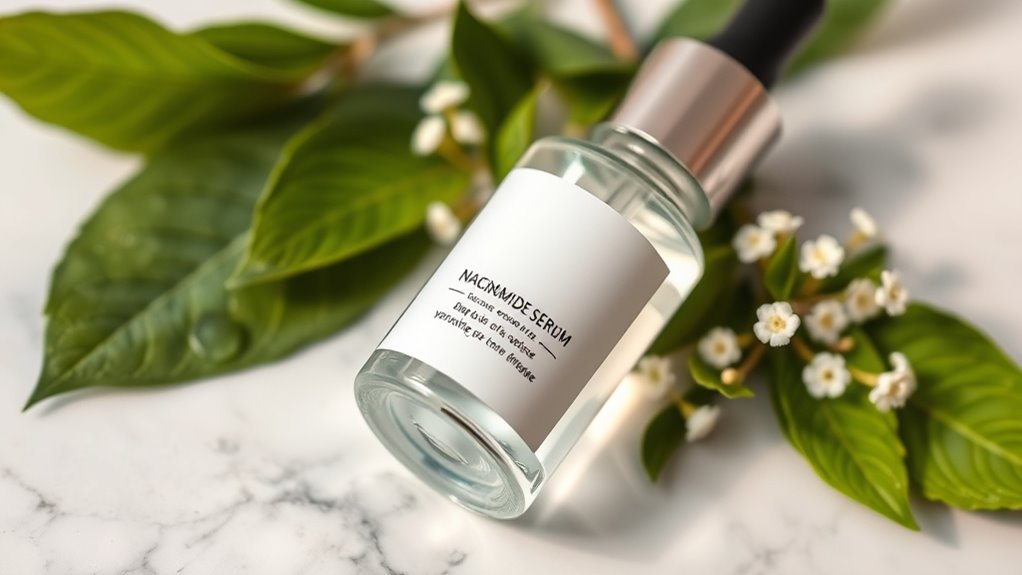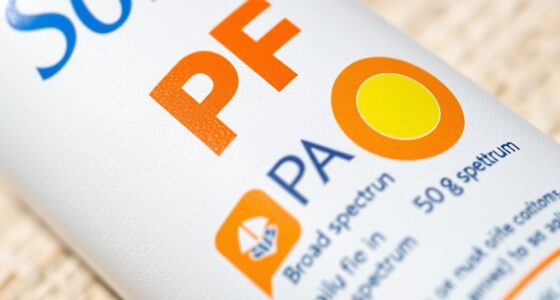Niacinamide, or vitamin B3, is a versatile skincare ingredient that reduces inflammation, strengthens your skin barrier, and balances oil production. It boosts collagen, smooths fine lines, evens skin tone, and restores elasticity for a more youthful look. You can easily add it to your routine as a serum or moisturizer, applying morning or night. To learn more about maximizing its benefits and choosing the right products, keep exploring this guide.
Key Takeaways
- Niacinamide is a versatile vitamin B3 derivative that improves skin barrier, reduces inflammation, and regulates oil production.
- It boosts collagen, minimizes fine lines, brightens skin, and evens out skin tone for a youthful appearance.
- Incorporate it into your routine via serums or moisturizers, applying morning or night for best results.
- Choose products with 2-10% concentration suited to your skin type, and start with lower doses if sensitive.
- Generally safe, but perform patch tests and consult a dermatologist if you experience irritation or have sensitive skin.
What Is Niacinamide and How Does It Work?

Niacinamide, also known as vitamin B3, is a versatile skincare ingredient that offers numerous benefits for your skin. Its ingredient functions include reducing inflammation, strengthening the skin barrier, and balancing oil production. You’ll find niacinamide in many skincare formulations because it’s compatible with various ingredients and effective at low concentrations. When applied, it penetrates your skin to support cellular repair and improve your skin’s overall health. Its ability to regulate sebum makes it ideal for managing oily and acne-prone skin. Additionally, niacinamide helps minimize redness and blotchiness, promoting a more even skin tone. Its versatility allows it to be incorporated into different products, such as serums, moisturizers, and toners, making it easy to include in your daily skincare routine. Moreover, understanding the importance of skin health can help you appreciate how ingredients like niacinamide contribute to maintaining a vibrant complexion.
Top Skin Benefits of Niacinamide
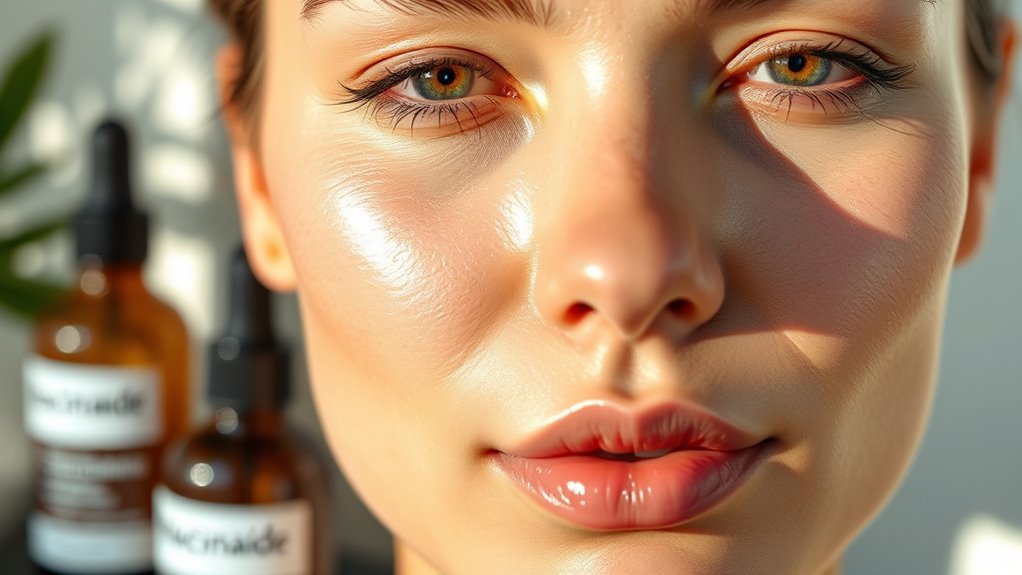
One of the main reasons niacinamide is a popular skincare ingredient is because of its impressive array of benefits for your skin. It helps reduce signs of aging by boosting collagen production, which diminishes fine lines and wrinkles. Niacinamide also targets uneven skin tone, brightening dull areas and evening out discoloration. Its anti-aging properties restore firmness and elasticity, giving your skin a more youthful appearance. Additionally, niacinamide strengthens your skin’s barrier, reducing moisture loss and calming inflammation. This ingredient’s connection to personal growth and discovery highlights its role in transforming skin health and boosting confidence.
How to Incorporate Niacinamide Into Your Skincare Routine
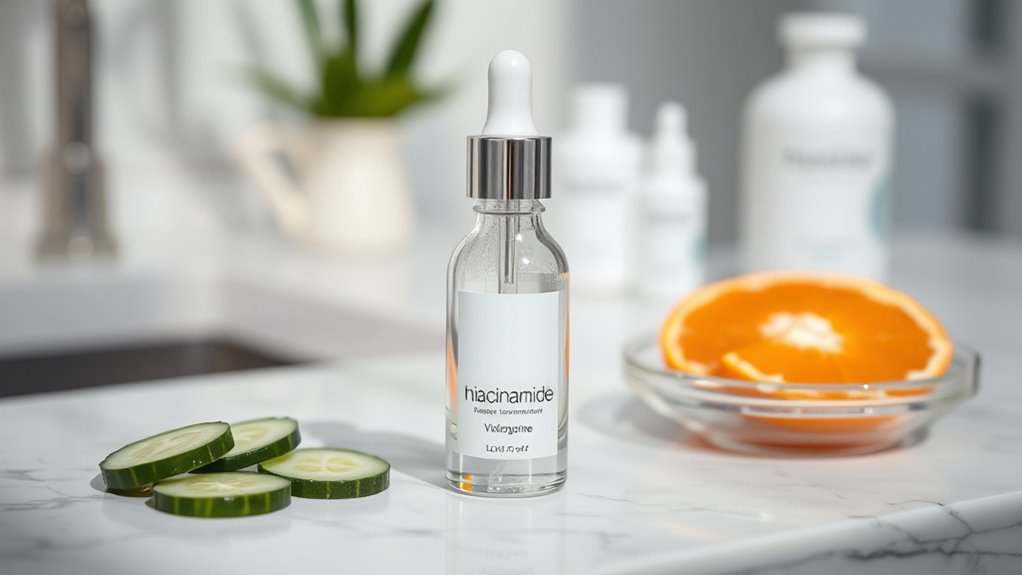
To effectively incorporate niacinamide into your skincare routine, start by choosing a product that contains a concentration suited to your skin’s needs, typically between 2% and 10%. Decide whether to use it as a serum or moisturizer—serums usually deliver a higher concentration and absorb faster, making them ideal for targeted treatment. You can apply niacinamide in the morning to help protect your skin throughout the day or in the evening to support skin repair overnight. Both options work well, so choose based on your schedule and skincare goals. If you use a niacinamide serum, follow with a moisturizer to lock in hydration. Incorporating it into your routine consistently will maximize its benefits and help you achieve healthier, more balanced skin. Color accuracy also influences the overall appearance of your skin, especially when using a high-quality niacinamide product.
Tips for Choosing the Right Niacinamide Products
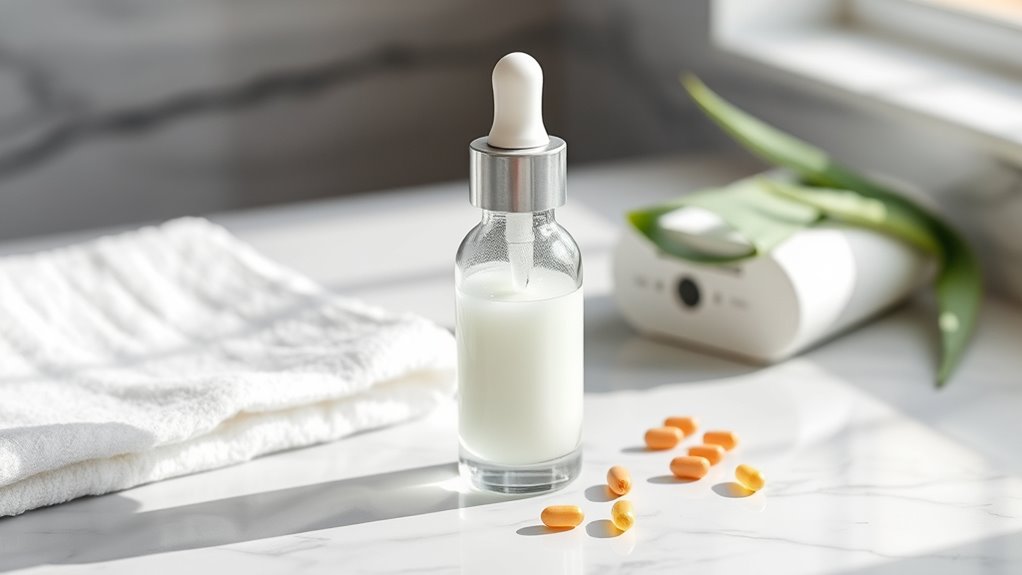
When selecting a niacinamide product, pay attention to the concentration level to guarantee it fits your skin’s needs. If you have sensitive skin, starting with a lower percentage can help prevent irritation, while higher concentrations may target specific concerns. Always consider your skin type to choose a formula that works best for you. Additionally, choosing products with appropriate formulation quality can enhance efficacy and reduce the risk of adverse reactions.
Concentration Levels Matter
Choosing the right niacinamide product depends heavily on its concentration level, as this impacts both effectiveness and your skin’s tolerance. Concentration variations can range from as low as 2% to as high as 10% or more. For sensitive skin, sticking to lower concentrations ensures you avoid irritation while still gaining benefits. Higher concentrations, like 10%, may offer faster results for issues like hyperpigmentation or enlarged pores but can increase the risk of irritation if your skin is sensitive. The key is finding the ideal dosage for your skin type and concerns. Start with lower concentrations to gauge your skin’s response, then gradually increase if needed. Remember, more isn’t always better; the right concentration balances efficacy with comfort. Regularly checking for changes in scent or consistency can help you determine if your product remains effective and safe over time.
Consider Skin Type
Selecting the right niacinamide product starts with understanding your skin type. If you have oily or acne-prone skin, look for formulations labeled as oil-free or non-comedogenic to guarantee skin type compatibility. Those with dry or sensitive skin should choose gentle formulations, possibly with added soothing ingredients, to minimize ingredient sensitivities. For combination skin, select products that balance moisture and oil control. Check the ingredient list for potential irritants if you have sensitive skin. Always patch-test new products before full application. Knowing your skin type helps you pick niacinamide products that deliver benefits without causing adverse reactions. This careful approach ensures you get the most out of your skincare routine while avoiding unnecessary irritation. Additionally, understanding your skin’s unique needs can help you incorporate targeted solutions that address specific concerns effectively.
Potential Side Effects and Precautions
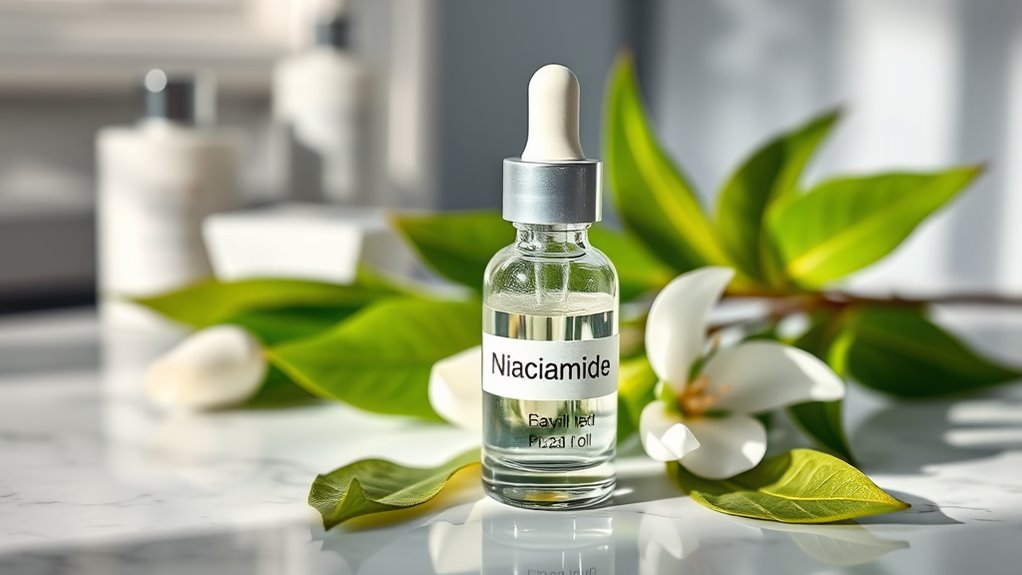
While niacinamide is generally considered safe for most skin types, some individuals may experience side effects or need to take precautions. Allergic reactions are rare but possible, so perform a patch test before full application. If you notice redness, itching, or swelling, discontinue use immediately. To minimize risks, follow proper application tips: start with a lower concentration and gradually increase. Avoid applying niacinamide on broken or irritated skin to prevent irritation. Always consult a dermatologist if you have sensitive skin or allergies. Incorporating proper skincare practices can also help reduce the likelihood of adverse reactions. Here’s a quick guide:
| Precaution | Possible Side Effect | Application Tips |
|---|---|---|
| Patch test | Allergic reactions | Use small amount first |
| Avoid broken skin | Irritation | Apply on clean, dry skin |
| Gradually increase use | Redness, itching | Follow product instructions |
| Consult dermatologist | Unusual reactions | Seek advice if unsure |
Frequently Recommended Niacinamide Combinations

Combining niacinamide with other skincare ingredients can enhance its benefits and address specific skin concerns more effectively. Proper pairing ingredients improve formulation stability and maximize results. Here are three frequently recommended combinations:
- Hyaluronic Acid – Boosts hydration and complements niacinamide’s calming properties, creating a plump, smooth complexion.
- Vitamin C – When carefully formulated, this pairing brightens skin and evens tone without destabilizing either ingredient.
- Zinc Oxide – Enhances oil control and reduces inflammation, making it ideal for acne-prone skin while maintaining formulation stability.
Using these combinations thoughtfully guarantees you get the most out of niacinamide’s benefits without compromising the product’s effectiveness. ingredient stability is crucial for ensuring that the formulations remain effective over time.
Frequently Asked Questions
Can Niacinamide Be Used With Prescription Medications?
Yes, you can generally use niacinamide with prescription medications, but you should always verify for potential drug interactions. It’s best to consult your dermatologist before combining niacinamide with your medications to ensure safety. They can advise you on any risks and proper usage, especially if you’re on treatments for skin conditions or other health issues. Always follow your healthcare provider’s guidance to avoid any adverse effects.
How Long Does It Take to See Results From Niacinamide?
They say patience is a virtue, and with niacinamide, it’s true. Typically, you’ll start seeing skin improvement rates within 4 to 6 weeks, but some may notice changes sooner. The timeline expectations vary depending on your skin concern and consistency. Keep using it daily, and with time, you’ll notice a clearer, more even complexion. Remember, skincare is a marathon, not a sprint!
Is Niacinamide Suitable for Sensitive or Allergy-Prone Skin?
Yes, niacinamide is suitable for sensitive or allergy-prone skin because it has a gentle formulation that minimizes irritation. It’s well-tolerated by most skin types and can help reduce redness and inflammation. However, you should always check for allergy considerations by doing a patch test first. When incorporated correctly, niacinamide can strengthen your skin barrier and improve your skin’s overall health without causing adverse reactions.
Can Niacinamide Help With Hyperpigmentation or Dark Spots?
Ever wonder if niacinamide can brighten your skin? It definitely helps reduce hyperpigmentation and dark spots, making skin discoloration less noticeable. By inhibiting melanin transfer, niacinamide promotes a more even skin tone. Regular use can fade existing dark spots and prevent new ones from forming. So, if you’re looking to improve your skin’s clarity and brightness, incorporating niacinamide into your routine could be a smart move.
What Is the Best Concentration of Niacinamide for Beginners?
For beginner skincare, the best concentration of niacinamide is typically between 2% and 5%. Concentration guidelines suggest starting low to minimize any irritation and gradually increasing as your skin adapts. You should begin with a 2% formula, applying it twice daily, and observe how your skin responds. If tolerated well, you can consider moving up to 5% for more targeted benefits like reducing hyperpigmentation or controlling oil.
Conclusion
If you’re worried about sensitivity, start with a lower concentration of niacinamide to see how your skin reacts. It’s a versatile ingredient that offers numerous benefits, from reducing redness to improving skin texture. Even if you have sensitive skin, incorporating niacinamide gradually can help you enjoy clearer, healthier skin without irritation. Give it a try—it’s a gentle yet powerful addition to your skincare routine that can make a noticeable difference.
